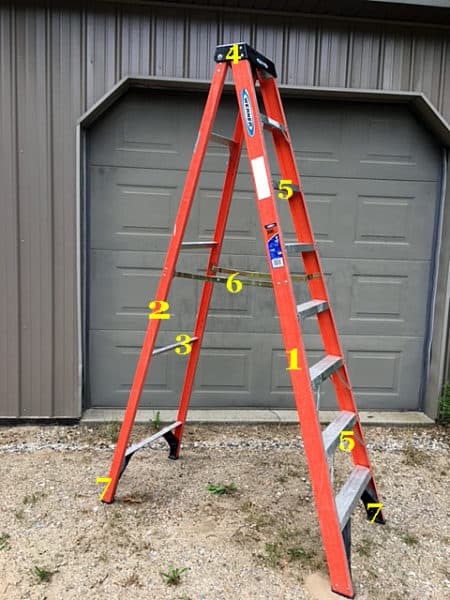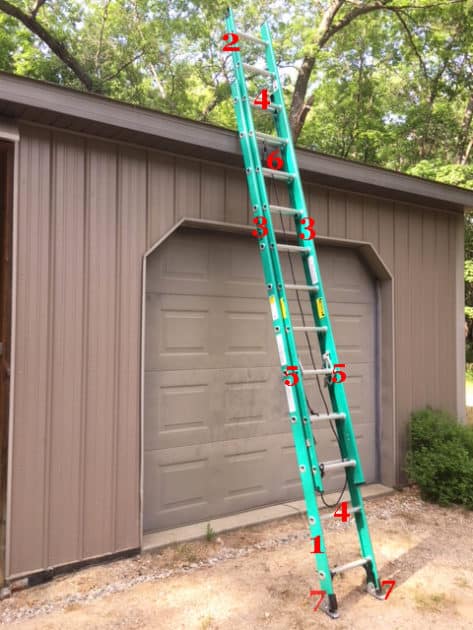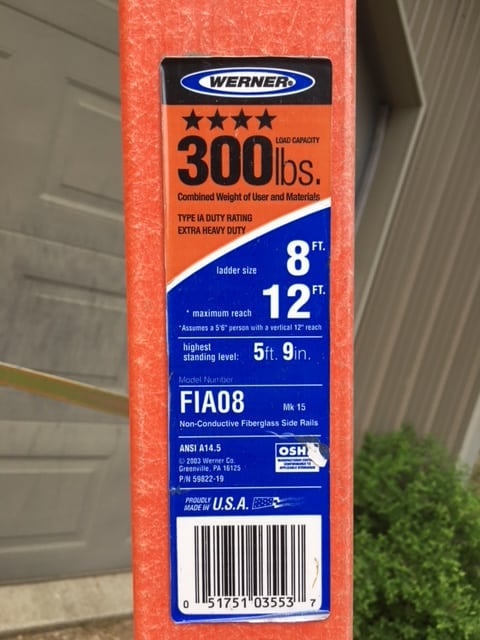How often do you use a ladder at home? Are you taking your time and using them correctly? In this article, I’d like to share with you a few tips on selecting the right ladder for the job and cover some basic safety tips when working from a ladder. These two things can save you from a potentially serious fall. Please take the time to read it so you don’t become a statistic!
According to the Occupational Safety and Health Administration (OSHA) “falls are among the most common causes of serious work-related injuries and deaths”. This has led to a number of laws and regulations to be put in place to help reduce those types of injuries. Most business owners are there to help enforce those rules to protect their workers.
But what about homeowners? Who’s there to help make sure you are following those best work practices. Chances are nobody. That’s why it’s up to each of us to become familiar with some of these guidelines and best practices to help protect all of us while working from a ladder.
Did you know thousands of people
As you can see from the statistics, a fall from a ladder doesn’t have to be from a great height to cause serious injuries or death. Ladder safety is pretty straightforward if you apply some basic common sense guidelines. Let’s take a look at some good ways you can reduce the odds of getting injured.
Anatomy of a ladder
Table of Contents
First, let’s look at the two most commonly used types of ladders. They are the step ladder and the extension ladder. This article will focus on these two because it will cover 80% of the ladders homeowners own and use. There are a few specialty ladders that can be adjusted, and folded, and used in a variety of different ways. For these types of ladders be sure to read and follow all the manufacturers instructions for proper use.
To better understand and apply the basic safety rules on how to use ladders we’ll need to know their parts. The pictures below have the components labeled. Become familiar with them and refer back to them when we look at the basic ladder safety tips.
Step Ladder

Extension Ladder

Common Ladder Materials
Ladders used by the average homeowner are typically made of three common materials. Those materials are wood, fiberglass, and aluminum. Each material has its advantages and disadvantages. These properties play a significant role in selecting the right ladder for the job. Let’s take a look at the different materials and the pros and cons of each.
Wood
Wooden ladders are okay for smaller multi-purpose use. Wood ladders are non-conductive as long and they are dry. Wooden ladders are heavier than fiberglass or aluminum. They can also loosen up over time, which can make them unstable. If left outside, wood can be damaged by moisture, splinter and will weaken over time.
Fiberglass
Fiberglass ladders are lighter than wood. More secure than wood and will not loosen up like wood. Their best attribute is they are non-conductive. If stored outside, sun (ultraviolet light) and weather can break down fiberglass over a long period of time.
Aluminum
M
Fiberglass and aluminum are normally used for extension ladders and taller step ladders. Because they are lighter, along with being stronger than wood, makes them the better choice. As a matter of fact, wood is slowly being phased out and being replaced by fiberglass and aluminum because of their superior properties.
Ladder Selection
If you are looking to buy a ladder or need to select one for a particular job, there are a few things you should consider. I personally have four ladders, along with a few step stools. Two of the ladders are made of aluminum and two are fiberglass. I use all of them and they all have their place. Below are some important things to look at when making your decision. This article from Sherwin-Williams has some good guidelines for selecting the correct ladder length.
Ladder Material Selection
When it comes to materials one of the main factors is are you going to be using it for any type of electrical work. If so, you definitely want a non-conductive material. The obvious choice here is fiberglass. If electrical work is not a consideration, then the choice gets down to personal preference. Fiberglass actually offers a little more strength when it comes to the taller extension ladders. However, aluminum is lighter than fiberglass.
Ladder Length Or Height Selection
The Sherwin-Williams article referenced above does a good job of showing you the proper ladder lengths to use. Let’s look at some of the highlights for both stepladders and extension ladders.

When using an extension ladder you should never use one fully extended. It’s best to have at least three feet of overlap between the base and fly sections. You should also have three feet of ladder extended above your work. I’ll talk a little more about this below.
For stepladders, the recommended minimum ladder length is four feet below the height of your work. Why’s that? Another rule we’ll look at below is not to stand on the top two steps of a step ladder. Not using those two steps reduces the usable height of the ladder by two feet. The average height of a man in the US is 5’10”. Subtract that two-foot reduction from the 5’10” and you’re left with approximately four feet. That puts your work area right at face level, while on a step ladder.
Ladder Weight Rating
All ladders will have a weight rating. It’s important not to exceed that rating. What many fail to consider is it is not only your personal weight but also the weight of anything you may be wearing. Wearing a heavy coat, a pair of work boots, and something like a tool belt can add up quickly. Just be aware and factor these things in.
Safety Guidelines When Working From A Ladder
Ladder safety is a combination of several things. Ladder selection, proper set up and using the ladder correctly. We’ve already talked a little about ladder selection, so below we’ll look at some the “best practices” related to ladder use. This is the meat and potatoes for ladder safety!
Common Ladder Safety Best Practices
The items in this section can and should be applied to any ladder you use. This includes stepladders, extension ladders, and everything in between.
Stepladder Safety Rules
Here are a few safety rules that apply more specifically to step ladders.
Extension Ladder Safety Rules
Here are a few safety rules that apply to extension ladders.
NIOSH Smartphone Ladder Safety Application
The National Institute for Occupational Safety and Health (NIOSH) organization has created a
Tools – This app can help you verify that your ladder is set at the proper angle and that it is level. Applying the rules of thumb mentioned above will aid you in getting your ladder safely set up. By using this app you will get a visual verification that will give you peace of mind. Watch the video below for a brief demonstration.
Ladder Safety Information – The app has a section loaded with ladders safety information too. If you’re ever on a job site and have a safety concern, the answer is right at your fingertips. Caution: this does not replace the need to read the manufacturers instructions for your personal ladder, but it is a great resource that will definitely help with safe ladder usage.
Ladder Safety Accessories
There are many ladder accessories out there that can help improve the safe use of ladders. If you are faced with an unusual or difficult situation, look to see what is currently available that can help you before improvising a solution. Amazon has a large selection of ladder accessories. I’ve placed several of these devices in the list below. Those links will provide you with more information and current pricing. While on Amazon search for “ladder accessories” or “ladder safety accessories”. They have many items to help improve ladder safety. FYI, we are a member of the Amazon affiliate program. For more information read our “Affiliate Disclosure” in the sidebar.
Ladder Safety Accessories
When using these ladder accessories, be sure to follow the manufacture’s instructions.
Conclusion
As you can see there are many factors that go into selecting the right ladder for the job. How tall or long of a ladder do I need? Is it made of the right material for the job? What is my ladder’s weight limit? Then there are many good practices for working from a ladder safely. I hope this article has pointed out some new, or at least different, ways of looking at things pertaining to ladder safety.
Ladders are a great tool and a must-have for home DIY’ers. But like with any tool, safety has to be at the top of our list. The NIOSH smartphone app has a couple of great tools to help and makes these ladder safety guidelines readily available to you. It’s up to each of us to make sure we work as safely as possible not only at our place of work but at home too. Be safe!
If you have any comments or questions, you can leave them in the comments section below or you can email us at [email protected]. FYI, we do not collect or share email addresses. We will only use them to reply to your comments or provide answers to your questions. We are also required to let you know that some of our links are “affiliate links”. This means if you click on a link and make a purchase, we could make a small commission, at no extra cost to you. This helps offset the cost of maintaining our website. So, if you like what you’ve seen, please be sure to give us a “Like” and “Share” on Facebook and Instagram too. Thank you for reading and good luck with all your home projects!


I agree. It’s better to be safe than sorry.
It’s great that this article mentioned that having a second person to help you while working on a ladder is really important. My father is planning on doing some work on our roof this weekend, and he wants to buy a ladder with an extension so that he can get all of his work complete. It might be a good idea for him to ask one of his neighbors to help him so that he doesn’t fall off and get hurt.